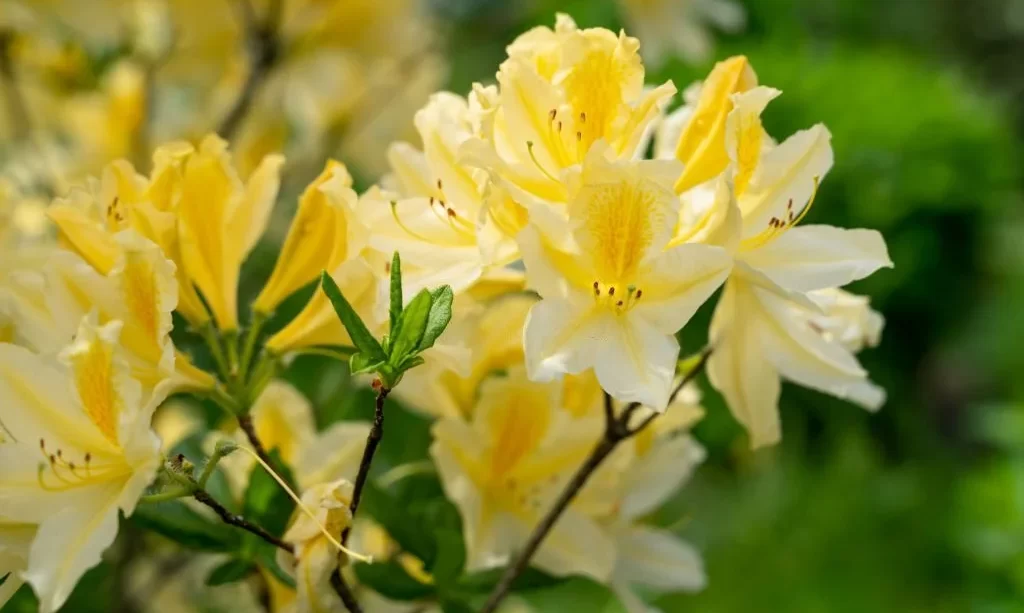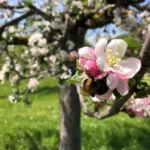Azaleas, with their stunning and abundant blooms, have earned their place as beloved garden additions. These vibrant flowering shrubs are cherished for the splashes of color they bring to landscapes, particularly in spring. Yet, a common question lingers in the minds of garden enthusiasts: Can azaleas bask in full sun, or do they thrive best in the cool embrace of shade? This inquiry arises from a desire to optimize the growth and beauty of these plants. In this article, we embark on a journey to explore the relationship between azaleas and sunlight. To understand whether azaleas can truly embrace the full sun, we must first delve into the world of these captivating shrubs, their diverse varieties, and their native habitats. Join us as we unlock the secrets of azaleas and their affinity for sunlight.
- Semi double rich purple flowers with green foliage
- USDA zones 6-10
- Plant in sun to part shade
- Expected Blooming Period: Spring To Fall
- Deepedt purple Encore Azalea on the market! Rich hues of violet from Spring to first Frost! Impossibly beautiful clusters of blooms
Azaleas
Before we address the question of sun exposure, it’s essential to acquaint ourselves with the essence of azaleas:
Botanical Marvels:
- Azaleas belong to the Rhododendron genus and are known for their spectacular blooms, which range from whites and pinks to reds and purples.
- These shrubs are categorized into two primary groups: deciduous azaleas, which shed their leaves in winter, and evergreen azaleas, which retain their foliage year-round.
A Diversity of Varieties:
- Azaleas offer a vast array of species and cultivars, each with its unique characteristics.
- They come in various sizes, growth habits, and flower shapes, allowing for a multitude of landscaping possibilities.
Native Habitats and Preferences:
- Azaleas are native to diverse regions, including Asia, North America, and Europe.
- In their native habitats, they often inhabit wooded areas where they receive dappled sunlight and grow in well-draining soils.
This understanding of azaleas as diverse, captivating, and native to specific environments forms the foundation for our exploration into their tolerance for full sun exposure.
Native Habitat and Growing Conditions
To comprehend how azaleas interact with sunlight, it’s crucial to examine their native habitat and preferred growing conditions:
Natural Habitats of Azaleas:
- Azaleas thrive in a variety of habitats, ranging from the deciduous forests of North America to the high mountains of Asia.
- In their native environments, they often occupy the understory of woodlands, benefitting from the dappled sunlight that filters through the canopy.
Acidic Soil and Moisture:
- Azaleas have a particular affinity for acidic soils, which are typically rich in organic matter and well-draining.
- Adequate moisture is essential for their health, and they tend to prosper in regions with consistent rainfall.
Partial Shade Preferences:
- The native habitats of azaleas provide them with partial shade, as the overhead canopy of trees and shrubs creates a filtered, gentle sunlight.
- These conditions have influenced the perception that azaleas prefer partial shade over full sun.
- PLANT FOOD: For All Acid loving plants and high pH soils featuring Nitrogen (9%), Phosphate (13%), and Soluble Potash (11%). Contains four acidifying sources to lower the soil pH factor to create prosperous growing environment; three sources of nitrogen for green up and to avoid root burn; three sources of Iron (3.2%) to ensure plant health, deep and dark green leaves, Cottonseed (20%) to feed plants slowly and consistently.
- FERTILIZER FOR ACIDIC SOILS: Excellent source of nutrients and minerals for in ground and container flowering acid loving plants including but not limited to: Azalea, Camellias, Gardenias, Magnolias, Dogwoods, Ferns, Red Bud, Jasmines, Hydrangea, Caladiums, Roses, Evergreen Shrubs, Flowering Trees and Evergreens.
- PLANT FERTILIZER: Helps flowering acid loving plants to improve tolerance to dry weather conditions, in addition to promoting heavy flowering while increasing the size and strengths of the plant. Apply in the beginning of spring and then every other month during growing season.
- IMMEDIATE RESULTS: NutriStar works with the soil and the soil biology to provide your plants with the best nutrition at the right time and in the right amount. Your plants get an immediate boost upon application, coupled with lasting benefits that continue to feed.
- SUPERIOR QUALITY: The leading landscapers’ choice for flowers for over 30 years. Nelson Plant Food builds products that are horticulturally correct for each type of plant. Extensive research is done to make sure that plants are fed correctly with each NutriStar or ColorStar product.
Can Azaleas Handle Full Sun?
The question of whether azaleas can withstand full sun is a common one among gardeners. Here’s a closer look at their sun tolerance:
General Sun Sensitivity:
- Azaleas are often considered sensitive to prolonged exposure to full sun, especially in regions with hot and arid climates.
- Intense sunlight can stress the plants and lead to issues such as leaf scorch and reduced flowering.
Partial Shade Preference:
- The general consensus is that azaleas tend to thrive in partial shade, where they receive some protection from direct sunlight.
- Partial shade mimics their native conditions and encourages optimal growth and blooming.
Factors Affecting Sun Tolerance
While azaleas may have a reputation for preferring shade, several factors influence their ability to tolerate sunlight:
Azalea Variety:
- Different azalea varieties exhibit varying degrees of sun tolerance. Some are naturally more resilient to full sun than others.
Climate and Region:
- Climate plays a significant role, as azaleas in cooler, more temperate climates may tolerate more sun than those in hot, sunny regions.
Soil Conditions:
- Well-draining, acidic soil is essential for azaleas, regardless of sun exposure. Soil quality affects their overall health and ability to withstand sunlight.
Understanding these factors is essential for gardeners aiming to strike the right balance between sunlight and shade for their azaleas.
Sun-Tolerant Azalea Varieties
While many azaleas prefer partial shade, some varieties are better equipped to handle full sun exposure. Here are a few sun-tolerant azalea varieties:
Southern Indica Azaleas:
- Southern Indica azaleas are evergreen varieties known for their robust nature and sun tolerance.
- They are particularly well-suited for warmer climates and can thrive in areas with extended sunlight.
Encore Azaleas:
- Encore azaleas have gained popularity for their ability to bloom not only in spring but also in summer and fall.
- Some Encore varieties, such as the Autumn Twist, are known for their tolerance of full sun conditions.
Deciduous Azalea Varieties:
- Some deciduous azalea species, like the Florida Flame Azalea (Rhododendron austrinum), are more adaptable to full sun and can dazzle with vibrant spring blooms.
- Semi double red-orange flowers with green foliage
- Plant in sun to part shade; water daily until established
- Blooms spring, summer, and fall; USDA zones 6-10
- Expected Blooming Period: Spring To Fall
- Sunlight Exposure: Partial Shade
Care Tips for Azaleas in Full Sun
Caring for azaleas in full sun requires attention to detail and specific practices:
Proper Watering:
- Azaleas in full sun may require more frequent watering, especially during hot and dry periods.
- Water deeply to ensure the root zone remains consistently moist but not waterlogged.
Mulching:
- Apply a layer of organic mulch around the base of azaleas to help retain soil moisture, regulate soil temperature, and suppress weeds.
Pruning and Shaping:
- Regular pruning can promote air circulation and reduce stress on the plants. Remove dead or crowded branches to encourage healthy growth.
Fertilization:
- Use a balanced, slow-release fertilizer designed for acid-loving plants to provide essential nutrients.
- Follow recommended fertilization schedules to avoid over-fertilizing.
Protection During Extreme Heat:
- During exceptionally hot and sunny days, consider providing temporary shade or using shade cloth to protect azaleas from intense sunlight.
- 14-7-7
- No mixing required
- Slow release
- Contains micronutirents
- 3.5 lbs
Conclusion
In conclusion, the relationship between azaleas and full sun is nuanced. While azaleas are often associated with partial shade, some varieties exhibit a remarkable tolerance for full sun conditions. Gardeners can take advantage of these sun-tolerant varieties to enjoy the vibrant beauty of azaleas in sunnier locations.
However, it’s crucial to remember that even sun-tolerant azaleas benefit from proper care, including adequate watering, mulching, and occasional shade during extreme heat. Understanding the specific needs of your azalea variety and your local climate will help you create the ideal conditions for these captivating shrubs to thrive, whether in full sun or partial shade. By striking the right balance between sunlight and care, you can enjoy the splendid blooms and lush foliage that azaleas are known for in your garden.







